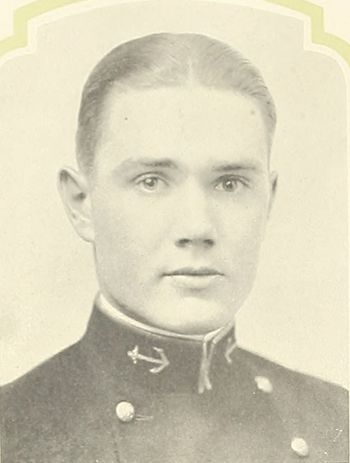CYRUS T. CLENDENING, LTJG, USN
Cyrus Clendening '27
Lucky Bag
From the 1927 Lucky Bag:
Cyrus Turner Clendening
Washington, D.C.
"Cy" "Storm King"
BORN in Savannah, Georgia, and roaming the southern states in successive years, Cy is a true rebel, as his southern drawl indicates. Though he has migrated as far north as Washington he still shouts as loud when "Dixie" is played as those of Alabama.
He prepped at Emerson Institute, where he won an "E" in football and baseball. From here, he entered George Washington, and was soon chosen to become a "Kappa Sig." He was all set to be a stockbroker; however, as an unlucky drop in the market lost him twenty-five dollars, he realized that banking was not his forte, and decided to go down to the sea in ships.
Plebe year kept him on the jump. However, he managed to find time to win honors in football and led the field in the 440. Youngster year, finding himself at a decided disadvantage at the hops, he immediately started to overcome this handicap, and became one of Schultz's boys. Hard work and application soon won him the name of a "Grappler among grapplers." His meteoric rise to fame on the cinder path was brought to an untimely halt by appendicitis.
Any one who is lucky enough to draw him for a shipmate is to be envied, for he has a true blue friend who will be the same whether "Lady Luck" smiles or frowns.
Football: B Squad (3, 2, 1) Class (4) Class Numerals (4) Navy Numerals (3, 2, 1); Track: Class (4) Navy Numerals (4).

Cyrus Turner Clendening
Washington, D.C.
"Cy" "Storm King"
BORN in Savannah, Georgia, and roaming the southern states in successive years, Cy is a true rebel, as his southern drawl indicates. Though he has migrated as far north as Washington he still shouts as loud when "Dixie" is played as those of Alabama.
He prepped at Emerson Institute, where he won an "E" in football and baseball. From here, he entered George Washington, and was soon chosen to become a "Kappa Sig." He was all set to be a stockbroker; however, as an unlucky drop in the market lost him twenty-five dollars, he realized that banking was not his forte, and decided to go down to the sea in ships.
Plebe year kept him on the jump. However, he managed to find time to win honors in football and led the field in the 440. Youngster year, finding himself at a decided disadvantage at the hops, he immediately started to overcome this handicap, and became one of Schultz's boys. Hard work and application soon won him the name of a "Grappler among grapplers." His meteoric rise to fame on the cinder path was brought to an untimely halt by appendicitis.
Any one who is lucky enough to draw him for a shipmate is to be envied, for he has a true blue friend who will be the same whether "Lady Luck" smiles or frowns.
Football: B Squad (3, 2, 1) Class (4) Class Numerals (4) Navy Numerals (3, 2, 1); Track: Class (4) Navy Numerals (4).
Loss
Cyrus was lost when the airship USS Akron (ZRS 4) crashed off the coast of New Jersey on April 4, 1933.
Other Information
From researcher Kathy Franz:
Cyrus' marriage to Sally Huntress was announced in November 1930. They had a daughter in 1932 named Diane. After his death, Sally married Lieutenant Henry Crommelin ('25) at the Naval Academy chapel. They had two children together, Henry, Jr. and Sally. Cyrus' father was also named Cyrus, and his mother remarried William Muehleisen of Virginia.
Akron's executive officer, LCDR Herbert V. Wiley '15, one of only three survivors, was filmed shortly after the crash:
Photographs
Related Articles
William Moffett '90, Fred Berry '08, Henry Cecil '10, Frank McCord '11, Harold Maclellan '18, Joseph Severyns '20, George Calnan '20, Richard Cross, Jr. '21, Herbert Wescoat '23, Robert Sayre '24, Charles Callaway '24, Hammond Dugan '24, Charles Miller '25, Charles Redfield '26, and Wilfred Bushnell '26 were also lost aboard Akron.
The "Register of Commissioned and Warrant Officers of the United States Navy and Marine Corps" was published annually from 1815 through at least the 1970s; it provided rank, command or station, and occasionally billet until the beginning of World War II when command/station was no longer included. Scanned copies were reviewed and data entered from the mid-1840s through 1922, when more-frequent Navy Directories were available.
The Navy Directory was a publication that provided information on the command, billet, and rank of every active and retired naval officer. Single editions have been found online from January 1915 and March 1918, and then from three to six editions per year from 1923 through 1940; the final edition is from April 1941.
The entries in both series of documents are sometimes cryptic and confusing. They are often inconsistent, even within an edition, with the name of commands; this is especially true for aviation squadrons in the 1920s and early 1930s.
Alumni listed at the same command may or may not have had significant interactions; they could have shared a stateroom or workspace, stood many hours of watch together… or, especially at the larger commands, they might not have known each other at all. The information provides the opportunity to draw connections that are otherwise invisible, though, and gives a fuller view of the professional experiences of these alumni in Memorial Hall.
January 1928
April 1928
July 1928
October 1928
January 1929
April 1929
July 1929
October 1929
January 1930
April 1930
October 1930
January 1931
April 1931
July 1931
October 1931
January 1932
April 1932
October 1932
January 1933
April 1933

The "category" links below lead to lists of related Honorees; use them to explore further the service and sacrifice of alumni in Memorial Hall.
